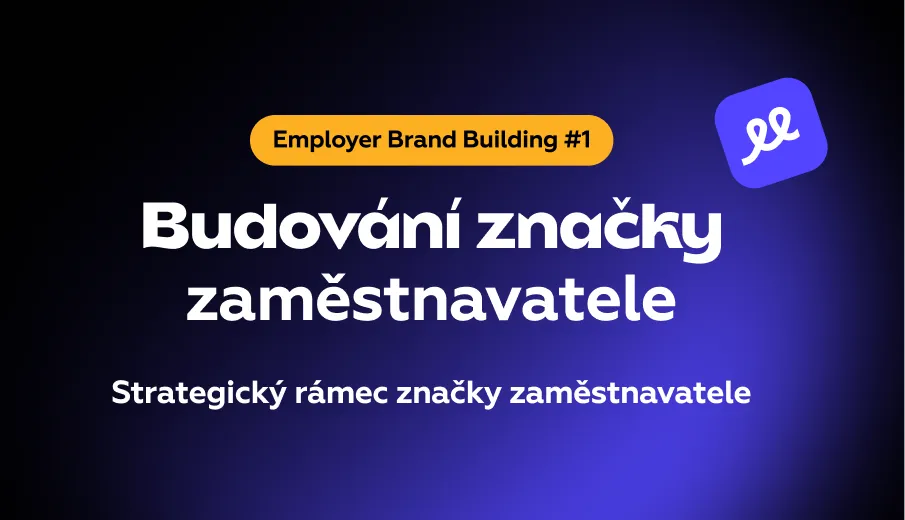Employer Brand Building #1: Strategic Framework for Employer Brand

These days, having a great product or service is no longer enough. A strong employer brand and an authentic corporate reputation are becoming the true differentiators. This e-book will guide you through the process of building an employer brand, focusing on authenticity, consistency, and aligning internal and external communication.
The need for a strong employer brand is even more urgent in the digital age, where information flows faster than ever before. It’s no longer sufficient to simply communicate your job offer — we’re witnessing the rise of a complex digital ecosystem in which candidates and employees expect a genuine alignment between what a company claims externally and the reality it creates internally. Social media, review platforms, and personal recommendations shape how your company is perceived as an employer far more than in the past. “Corporate newspeak” simply doesn’t work anymore.
According to a 2023 LinkedIn study, companies with a strong employer brand see 28% lower employee turnover, 50% lower recruitment costs, and attract 50% more qualified candidates. Furthermore, the PwC Global Workforce Hopes and Fears Survey 2024 reveals that up to 76% of skilled professionals consider a potential employer’s values and culture before even submitting a resume.
That’s why you need a strategic approach to how you present your company culture, values, and opportunities. Only then can you attract and retain the right talent in a time when competition in the labor market is more intense than ever.
Before we begin…
HR marketing and employer branding are often confused terms. While they are related, they represent different concepts.
- HR marketing is a broader term that includes the use of marketing tools and techniques in the human resources field. It encompasses all marketing activities related to recruitment, internal communication, and employee relationship management. It’s about the practical use of marketing channels (social media, email, content marketing) and strategies to achieve HR goals.
- Employer branding, on the other hand, is more specifically focused on building and managing the employer brand – that is, the overall impression people have of your company as a place to work. It’s a long-term strategic process of shaping an employer identity, which starts with corporate values and culture and is reflected in every interaction with candidates and employees.
The Relationship Between the Two
HR marketing consists of tools and activities that help build the employer brand. Employer branding is the strategic goal, while HR marketing provides the tactical means to achieve it.
Strategic Framework for Employer Brand
Employer branding is not just a marketing activity. It is a strategic process that connects corporate values, culture, and business goals with how employees, candidates, and the broader public perceive your company. At the core of this process is authenticity — the alignment between what is communicated externally and the reality within the organization. This alignment is critical because candidates and employees now actively verify whether a company’s promises match the actual experience.
An employer brand emerges at the intersection of corporate culture, employee experience, internal and external communication, and talent management. The most successful organizations understand that a strong employer brand starts from within — with satisfied and engaged employees who naturally become brand ambassadors. Leadership plays a key role here: it must not only declare values but also live them and embed them into everyday practices.
Employer Value Proposition (EVP) as the Heart of the Brand
The Employer Value Proposition (EVP) forms the foundation of your employer brand. It is the unique set of values, benefits, and opportunities you offer employees in exchange for their skills, talent, and commitment. An effective EVP must be authentic, relevant to your target audiences, and distinct from the competition.
EVP typically includes:
- Values and vision: Purpose, ethics, approach to innovation or sustainability
- Benefits: Financial rewards, wellness programs, flexibility, or educational support
- Development opportunities: Career growth, mentoring, workshops, or international projects
- Work environment: Culture, team dynamics, autonomy, or technical infrastructure
EVP should be a living document, regularly updated to reflect employee needs and market trends.
Measurable Benefits of a Strong Employer Brand
The benefits of a strong employer brand are tangible and quantifiable. According to a 2023 LinkedIn study, companies with a well-developed employer brand experience:
- 28% lower turnover: More satisfied employees stay longer, reducing recruitment costs.
- 50% lower recruitment costs: A strong EVP attracts qualified candidates who actively seek out the company — not the other way around.
- 50% more qualified candidates: Authentic storytelling and transparent communication increase talent loyalty.
Additional data confirms the economic impact:
- Shorter time to hire: Positions are filled more quickly due to increased interest from qualified applicants.
- Higher productivity: Employees who feel a sense of belonging to the company work more efficiently.
- Stronger competitive advantage: A strong employer brand becomes a differentiator in the labor market.
This measurability is key to convincing leadership of the strategic value of employer branding. Companies like Microsoft or Salesforce systematically track metrics such as retention rate or eNPS (Employee Net Promoter Score) to continuously improve their EVP.
You simply can’t go without measurement. If you’re unsure where, how, or why to begin, take a look at our in-depth e-book dedicated to HR analytics.
In the next part of the series, we’ll explore how to understand your target audiences.
This series is created in collaboration with the Association for Strategic Communication and Public Relations.




